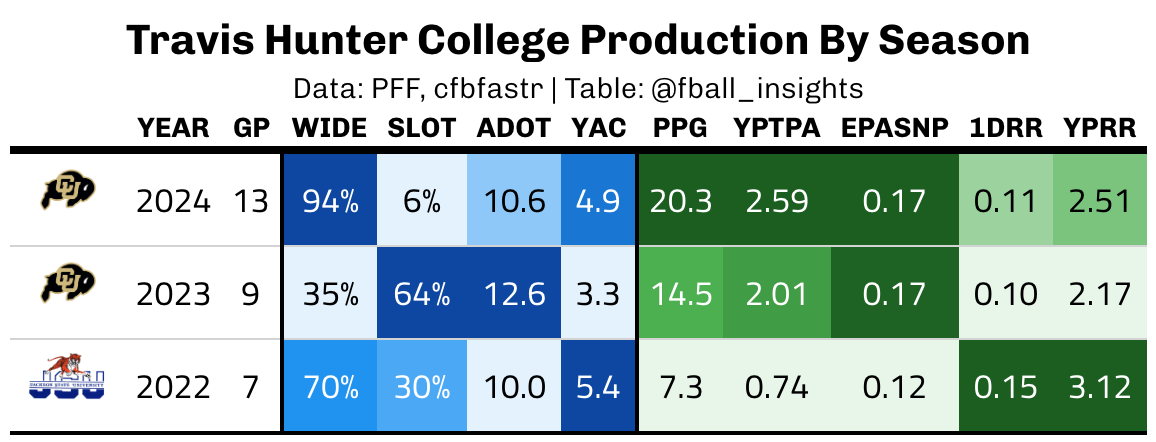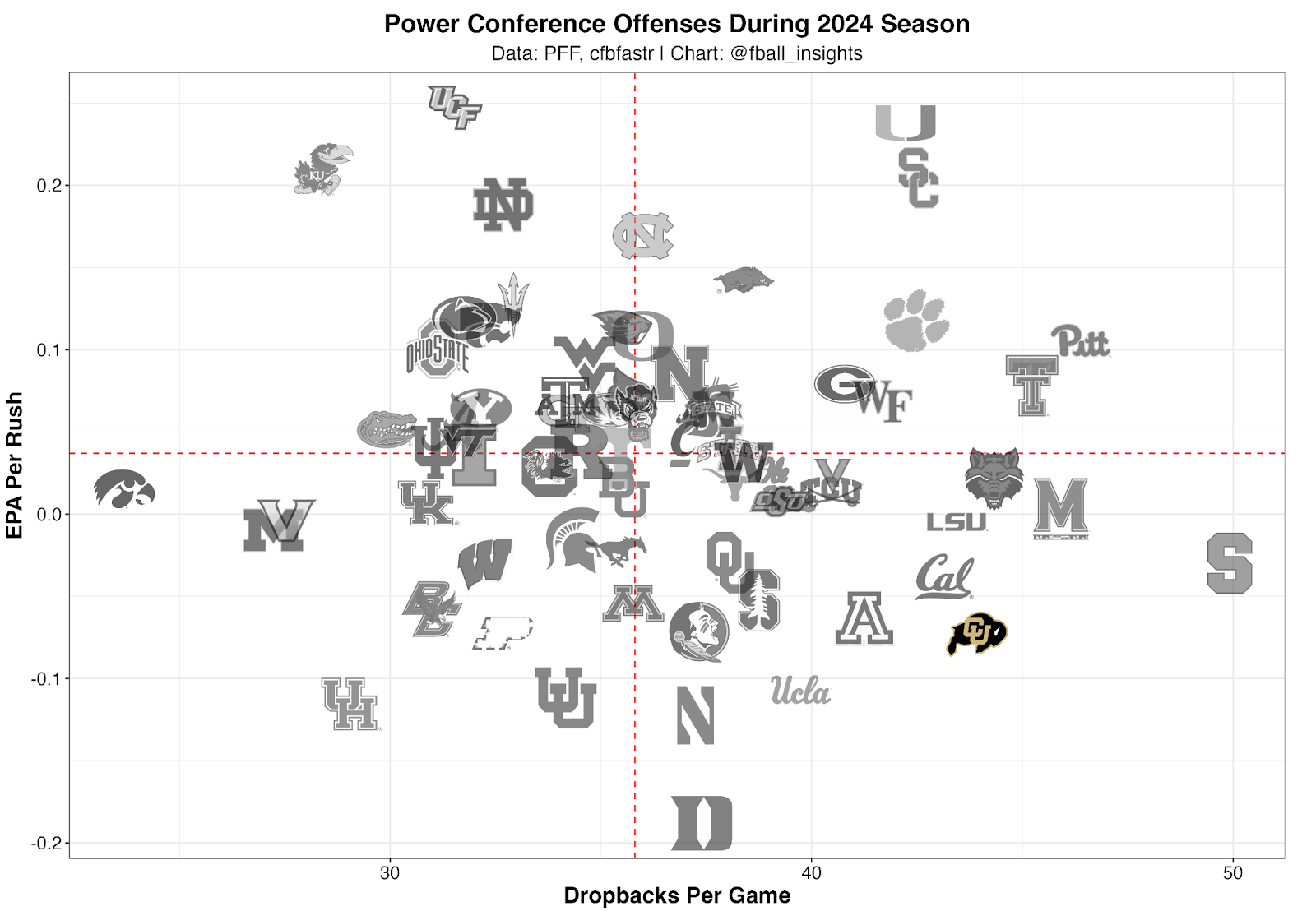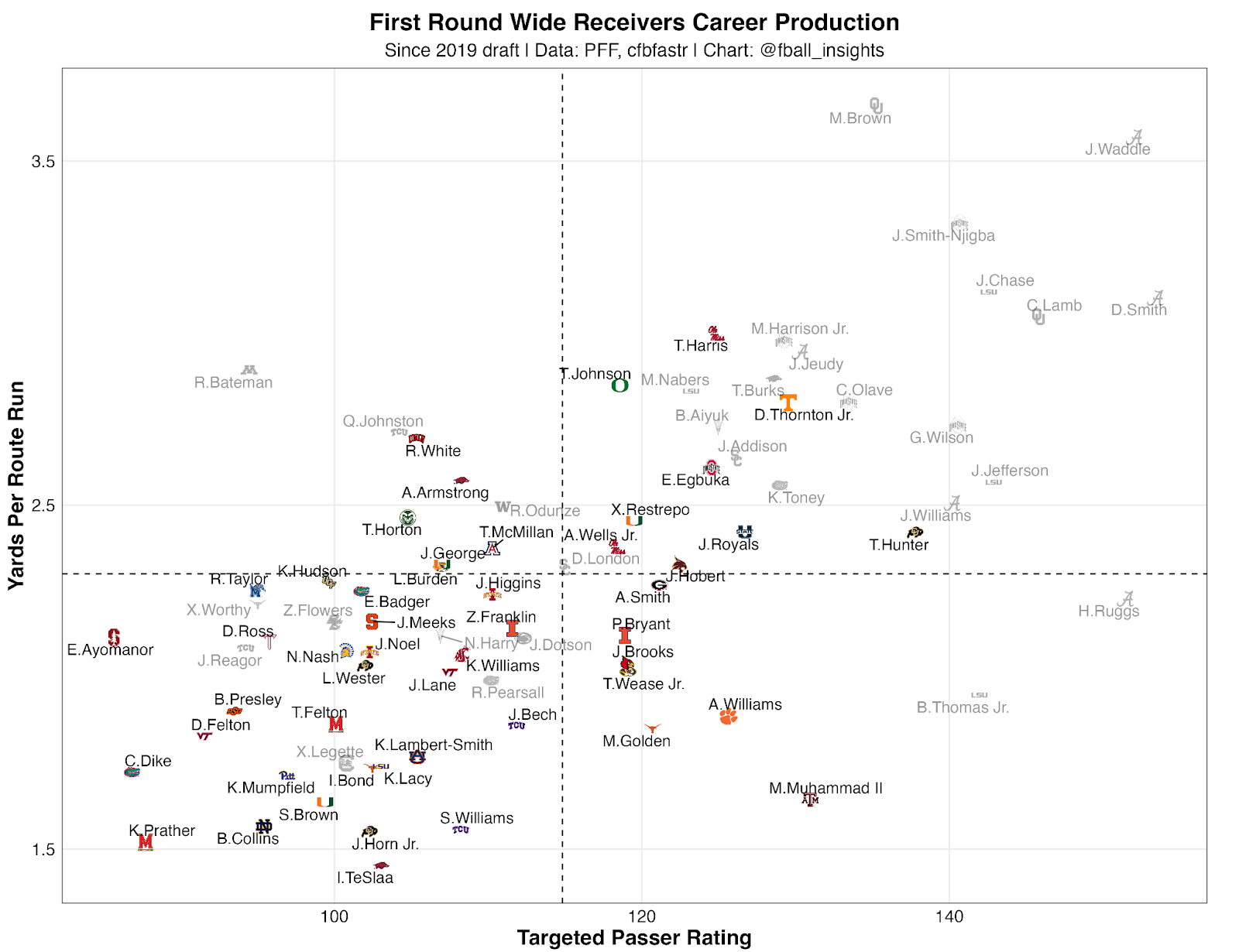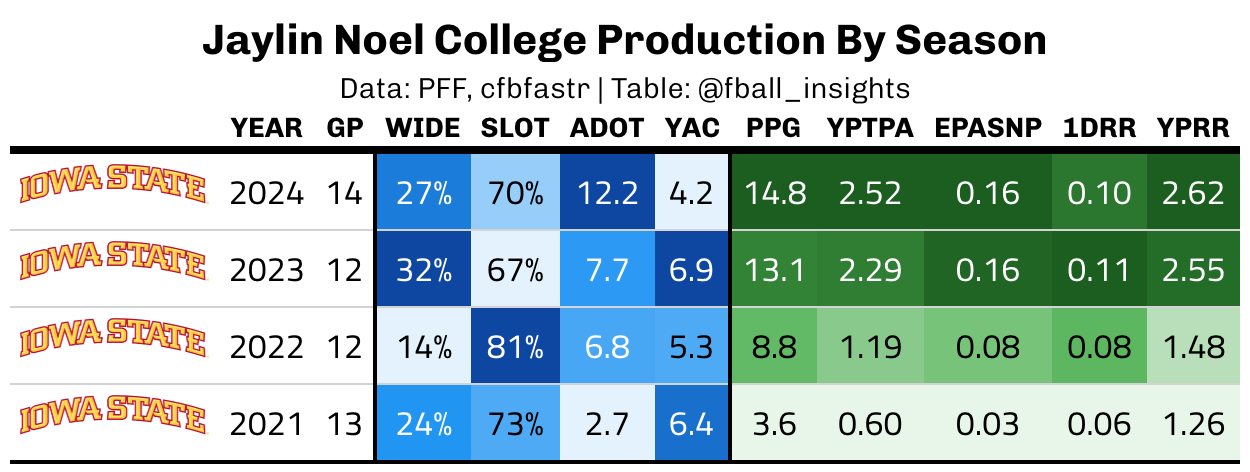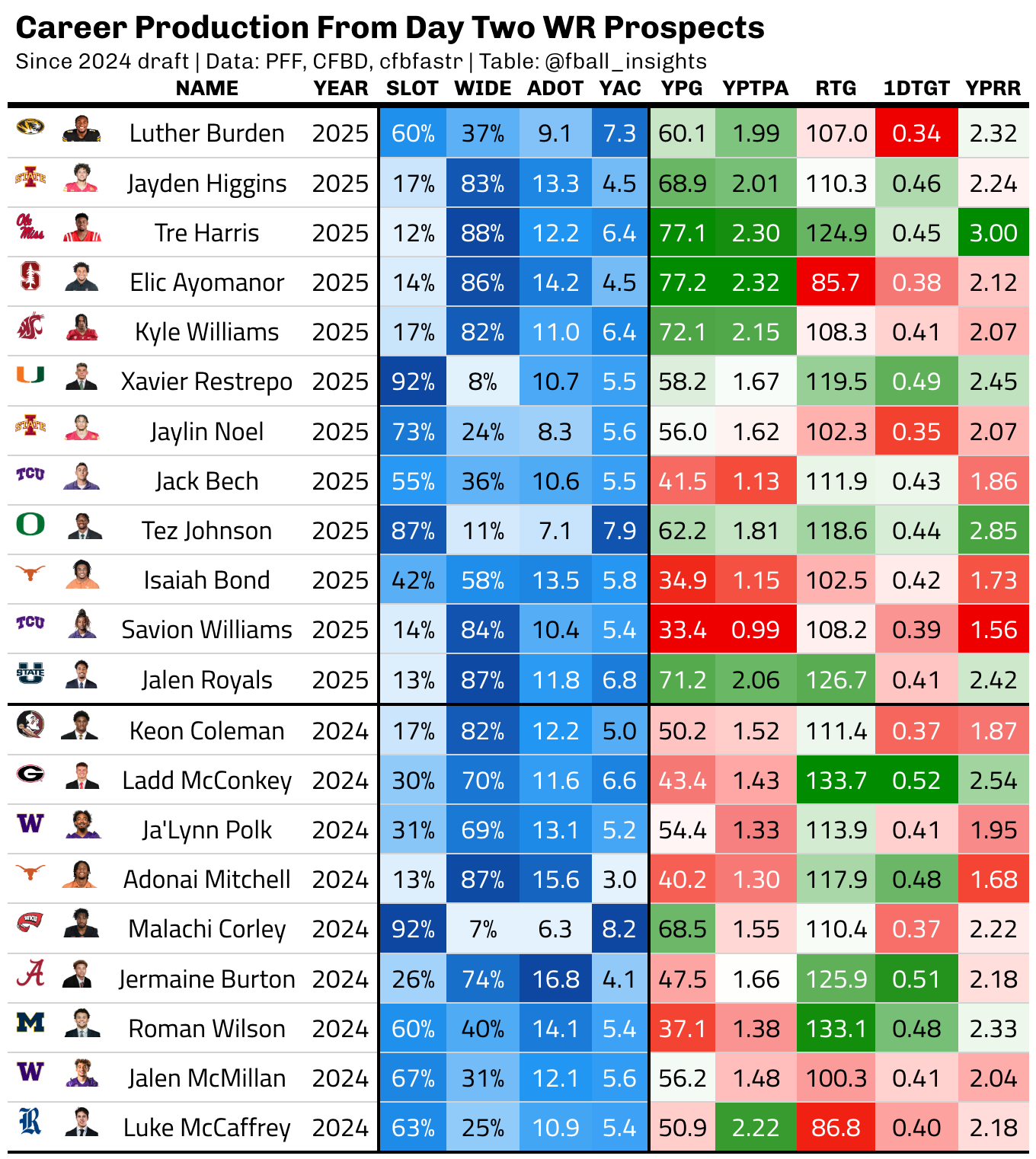This piece marks the second addition of the wide receiver prospect series I'll be pumping out this offseason. You can find the first article here.
As I mentioned in the first article of the series, this article and the foreseeable ones are centered around wide receivers. The plan is to cover up to four wideouts per writeup: One WR who is projected to be an early pick, one who is projected to be an early-to-middle-round pick, and finally, one or two Day Three analytics “sleepers.”
Let’s get right to it!
Tier 1: Travis Hunter | Colorado
Height: 6’1” | Weight: 185 | Age: 21.8
Hunter was a top recruit out of high school who first made headline news when he committed to FCS Jackson State to play for HC Deion Sanders and alongside Deion’s son Shedeur Sanders under center. Hunter played the 2022 season at Jackson State (with minimal snaps at WR) before transferring to Colorado in 2023 alongside the Sanders crew.
Hunter is obviously a unique player, given his full-time role on both sides of the football.
A quick deployment timeline courtesy of PFF:
2022
87 snaps in 7 games at WR
503 snaps in 9 games at CB
2023
452 snaps in 9 games at WR
592 snaps in 9 games at CB
2024
753 snaps in 13 games at WR
776 snaps in 13 games at CB
TLDR: Travis Hunter progressed from a CB to a full-time CB and WR.
There’s obviously a ton of projection when accessing his fantasy value Hunter, given the positional uncertainty.
My goal isn’t to predict his usage at either position or whether the team that drafts him keeps him in a hybrid role. Instead, I want to assess his receiving production up to this point and analyze his unique usage and what it could mean under an expanded receiving prioritization in the NFL.
Here is Travis Hunter’s season level production breakdown:
Among drafted WRs since 2019, the only players with a higher career passer rating when targeted are the following:
| Name | School | Draft | Round | Rating |
| DeVonta Smith | Alabama | 2021 | 1 | 153.4 |
| Jaylen Waddle | Alabama | 2021 | 1 | 152.0 |
| Henry Ruggs | Alabama | 2020 | 1 | 151.4 |
| CeeDee Lamb | Oklahoma | 2020 | 1 | 145.8 |
| Justin Jefferson | LSU | 2020 | 1 | 142.9 |
| Ja'Marr Chase | LSU | 2021 | 1 | 142.6 |
| Brian Thomas Jr. | LSU | 2024 | 1 | 142.0 |
| Jalin Hyatt | Tennessee | 2023 | 3 | 141.8 |
| Jaxon Smith-Njigba | Ohio State | 2023 | 1 | 140.7 |
| Garrett Wilson | Ohio State | 2022 | 1 | 140.6 |
| Marvin Mims | Oklahoma | 2023 | 2 | 140.3 |
| Jameson Williams | Alabama | 2022 | 1 | 140.2 |
| Troy Franklin | Oregon | 2024 | 4 | 138.2 |
| Travis Hunter | Colorado | 2025 | - | 137.8 |
I think this has some signal. The “non-premier” WRs on that list are more deep ball/gadget types, and over a longer time horizon, Travis Hunter fits a heavier target volume prototype.
Staying grounded in the production and what I see translate on tape, Travis Hunter shows subtle similarities to Chris Olave and Garrett Wilson depending on the area.
Hunter has more to offer in the YAC department than Olave, but Hunter was limited by certain contextual factors in that Colorado offense.
Career yards after the catch from WR prospects. Travis Hunter YAC on balls caught 10+ yards downfield stands out pic.twitter.com/e0YdaQEZkc
— Football Insights 📊 (@fball_insights) February 27, 2025
For instance, the Buffaloes frequently dropped back to pass and had an inefficient rushing attack. They were top ten in dropbacks per game and bottom ten in EPA per rush attempt:
I believe these variables are contributing factors to Colorado playing in more “expected pass” situations, ones where opposing defenses held the cards, ultimately limiting explosives/broken plays that other receivers capitalize on elsewhere.
Colorado went in more 4-5 WR sets, which makes sense given the game script context. However, given the expanded target competition on the field, this often makes it harder for a receiver to produce on a per-route basis.
Travis Hunter owns the lowest expected YPRR (1.27) among any WR prospect since 2019
— Football Insights 📊 (@fball_insights) March 25, 2025
Stems from usage. Ran more routes from 4-5 WR sets than any notable WR this cycle and ran the fewest from 3-WR sets per @PFF_Macri
Heavy expected pass situations and hybrid player with Colorado
This isn’t far off from what the Cincinnati Bengals' offense went through in the years following their 2021 Super Bowl run:
Pocket passing QB in shotgun
Great WRs
Low play action, motion usage
Uninspiring run game
OL questions
Weak defenses
But the drawbacks of that Bengal offense (and, similarly, Colorado’s) didn’t allow the opposing defense to be put into conflict, which means the QB and WR were playing on hard mode.
You saw the effects of this on WR Ja’Marr Chase, who wasn’t as explosive nor saw as many true one-on-one opportunities in the post-Super Bowl seasons prior to his monster 2024 campaign, which came on the back of tight, competitive game scripts.
Hunter was in a similar predicament at Colorado. Despite playing on both sides of the ball, he still put up highest-end production and slightly worse but still good efficiency given the context.
Again, we don’t know what the future holds and how often Hunter gets to play WR at the next level.
If he is a true hybrid as a rookie, at the very least, he likely sacrifices some offensive snaps, which intuitively happens more on early downs over the course of a season. If this were the case, it could further hinder explosive play opportunities (YAC), given more man/single-high looks coming on early downs.
If Hunter lands somewhere with a good run game and/or a dual-threat QB who induces busted coverage, it could help him draw more 1-on-1 reps and utilize innate YAC abilities that didn’t pop off as much in college, ultimately notching explosive plays and becoming a fantasy asset on less/same amount of snaps (“more bang for your buck”).
These are just examples of assessing exactly how much/little Hunter has in the tank as a WR threat and how things could play out in the near term.
In the long term, I believe Hunter has shown the potential to be an above-average fantasy producer, assuming he primarily commits to the offensive side of the ball.
Tier 2: Jaylin Noel | Iowa State
Height: 5’10” | Weight: 194 | Age: 22.5
Noel is slated to be a Round 3 selection. His stock has risen throughout the pre-draft process and I would be surprised if he’s not off the board on Day 2.
Noel is a compact, explosive WR out of the slot. He recorded over 50 targets in all four of his college seasons and over 80 targets in each of his final three seasons, according to PFF (remember this for later).
Noel improved both his output and efficiency year over year while at Iowa State:
From a career production standpoint, Noel is a bit underwhelming relative to his projected Day 2 draft capital. He’s a bit older and not exactly built with the length to sustain intense work as a run blocker.
Wide Receiver prospects career production pic.twitter.com/86KrXwqpmF
— Football Insights 📊 (@fball_insights) February 25, 2025
But Noel has also checked off many of the pre-draft process boxes, which you prefer to see given his underwhelming career production out of the slot.
As you might already know, Noel’s Iowa State teammate Jayden Higgins is also a prospect in this year’s WR class, and they really couldn’t be more different. Higgins is the bigger traditional X, while Noel is the smaller Z with short-area burst.
Despite these innate differences, both Iowa State WRs have raised popular backings throughout the draft cycle.
I do wonder how much of Noel’s growing faction stems from folks going to watch tape on Higgins:
According to PFF, Noel owns an 8.3 career average depth of target (ADOT). This figure is lower than any drafted WR since 2018 except the following:
| Name | School | Draft | Round | ADOT |
| Jalen Hurd | Baylor | 2019 | 3 | 4.8 |
| Ray-Ray McCloud | Clemson | 2018 | 6 | 5.0 |
| Rondale Moore | Purdue | 2021 | 2 | 5.4 |
| Parris Campbell | Ohio State | 2019 | 2 | 6.2 |
| Malachi Corley | Western Kentucky | 2024 | 3 | 6.3 |
| Amari Rodgers | Clemson | 2021 | 3 | 6.4 |
| Kadarius Toney | Florida | 2021 | 1 | 6.6 |
| K.J. Hill | Ohio State | 2020 | 7 | 7.6 |
| Velus Jones | Tennessee | 2022 | 3 | 7.7 |
| Wan'Dale Robinson | Kentucky | 2022 | 2 | 7.8 |
| Richie James | Middle Tennessee | 2018 | 7 | 8.0 |
| Jordan Whittington | Texas | 2024 | 6 | 8.0 |
| Kyle Philips | UCLA | 2022 | 5 | 8.1 |
| Anthony Schwartz | Auburn | 2021 | 3 | 8.1 |
If you remember Noel’s production table from earlier, however, not only did his output climb each season, but so did his aDOT: from 2.7 to 6.8 to 7.7 and finally to 12.2 in 2024.
One culprit for this criminally low initial aDOT is usage. 40.4% of Noel’s freshman targets were screens.
This number fell to 14% during his sophomore and junior seasons, and dropped to 6.7% his senior campaign.
And remember what I asked you to make a note of? He garnered more than 50 targets every year! This means that he was a consistent contributor on every team, buying even more credence to the trends at hand.
You could very well make the argument that the early gadgetry held Noel back from superior production, and there’s no denying that his numbers were good over his last few seasons.
Noel has impressive testing numbers, and he is built solidly for his sub-6’0” frame. His short area burst is also undeniable, so I understand trying the screen stuff early on. But moving off of that and letting his athleticism play out on downfield routes really contributed to his improvements and impact at the team level.
Jaylin Noel 4.39/41.5"/11'2"/6.82
— JetPack Galileo (@JetPackGalileo) March 2, 2025
Snapping it down pic.twitter.com/bBvk5zjOtP
Noel isn’t super long and ultimately doesn’t have amazing overall numbers. The physical aspects could call future deployment volumes into question, but there are definitely things to like as a projected Day 2 pick.
Ancillary vertical weapons like Christian Kirk have proven to be productive fantasy players on the backs volume in the recent past. Noel has continually improved and captured target volume every year of college football. There are certainly reasons to consider him in the middle rounds of your rookie drafts.
Tier 3: Kyle Williams | Washington State
Height: 5’11” | Weight: 190 | Age: 22.4
Williams played in five college seasons, beginning at UNLV in 2020 and continuing through 2022. Following the 2022 season, he transferred to Washington State for his final two seasons.
Williams had a productive 2024 year and began making himself more popular in the draft community at the Senior Bowl:
Kyle Williams was legitimately operating at a different speed than the DBs trying to cover him in 1 on 1s at the Senior Bowl pic.twitter.com/ejKVWeukJt
— Sam Monson (@SamMonsonNFL) March 24, 2025
But if you want to know what really put him on the map:
Draft WR Ranks are out and podcast is up
— Chris Simms (@CSimmsQB) March 24, 2025
Really really deep class pic.twitter.com/r9rvD4mGDY
Kyle Williams averaged 4.43 YPRR and led the country with 9 touchdowns vs man coverage in 2024, while averaging 2.28 YPRR vs zone, according to PFF.
Over his career, Williams averaged 2.47 YPRR vs man and 1.98 YPRR vs zone.
College players at 4+ YPRR and no drops vs Man last year per PFF (30+ targets)
— Football Insights 📊 (@fball_insights) March 29, 2025
- Kyle Williams
- Jeremiah Smith
There’s no denying what Williams is capable of in 1-on-1 situations. I think his relative success against man coverage is evident when you watch him in his best moments.
I can see how someone coming across cut-ups exclusively showing reps winning via burst/technique and digesting random data points without context would paint a strong picture of an unfamiliar prospect
Some of that is happening with Kyle Williams, as his exposure continues to skyrocket.
For example, nearly a quarter (24.3%) of Williams’ 2024 receptions were screens, and 25% of his 2023 receptions were screens when he played with QB Cam Ward.
In 2024, Williams had a 157.1 targeted passer rating on screens, compared to just an 81.4 rating in 2023.
He easily had his most productive year of college in 2024 as a fifth-year senior, and he hasn’t particularly been efficient vs zone on a larger sample size, something he’s more likely to see consistently in the NFL.
How much of his production-reliant game, where he was able to produce his peak-level output, is sustainable independent of situation and expected usage come Sundays?
Many of you have probably come across this rep vs Travis Hunter from 2023:
Kyle Williams has gained some buzz, but not enough. Easily a top 100 player.
— NFL Draft Files (@NFL_DF) March 23, 2025
Destroys single coverage no matter who he’s lined up against. pic.twitter.com/A4iTjuJPrb
When we zoom out, we see it was a less competitive battle throughout the game. Williams finished with 46 receiving yards and was targeted on 5 of 31 routes (16.1%) in a 56-14 blowout.
Kyle Williams vs Travis Hunter in 2023. Very good battle. pic.twitter.com/2BqMpq7uaa
— Billy M (@BillyM_91) March 29, 2025
Should he continue to climb draft boards, Kyle Williams has the raw production to at least meet the Day 2 threshold, preferably sneaking in Round 3.
You have to really value what you see on film to take Williams in Rounds 2-3. More specifically, I think you need a substantive plan for how he’ll add to your receiver room and what he will immediately bring to your offense, as he is an older prospect with defined strengths and weaknesses on a large sample.


